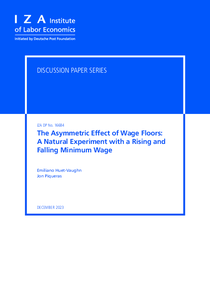The asymmetric effect of wage floors: A natural experiment with a rising and falling minimum wage

Huet-Vaughn, Emiliano ; Piqueras, Jon
Institute of Labor Economics, Bonn
IZA - Bonn
2024
28 p.
Discussion Paper
16684
Wages and wage payment systems
English
Bibliogr.
"Exploiting a unique natural experiment,we showthe asymmetric effects of a large increase and an equivalent subsequent decrease to a binding minimum wage. Wages in a leading low-wage industry increase as the minimumwage rises, but do not fall when it is lowered. This boost for low-wage workers' earnings is apparently permanent five years after the policy is revoked, providing novel evidence of hysteresis in wage setting from temporary labor policy. In the first year post repeal this is consistent with downward nominal wage rigidity. But, the elevated earnings persist even in high inflation times, contrary to the prediction from existing work that real wage reductions under high inflation should erode the nominal wage gap relative to unaffected firms. Our findings thus challenge the conventional view that inflation "greases the wheels" of the labor market in the face of downward nominal wage rigidity, and, demonstrate the value of even transitory labor market policy in achieving permanent gains for workers (play it while you got it)."
Digital
The ETUI is co-funded by the European Union. Views and opinions expressed are however those of the author(s) only and do not necessarily reflect those of the European Union or the ETUI.